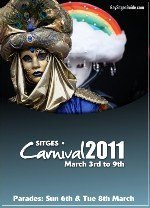The word carnival comes from the Italian carnevale and is a haplology of the word carnelevare, from the Latin carne, flesh, and levare, put away, because it marked the start of fasting and abstinence during Lent.
 |
It is believed that carnival began hundreds of years ago when the Catholics started the tradition of holding costume parties, eating in abundance andenjoying all possible excesses to prepare themselves to face uptothe somber 40 days of Lent. Over timethe traditions have evolved and adopted new symbols, but Carnival is still celebrated feverishly in Catalonia with fancy dress parties, parades and many old rituals. One of the customs is to eat omelette and butifarra d’ou (a type of Catalan sausage made with egg) on Dijous Llarder (fatty Thursday), which was originally the first day of Carnival. The festivities are presided by Carnestoltes, a straw figure that country folk hung from their barns and balconies during Carnival week, and still today represents the king of Carnival. Ash Wednesday is the first day of Lent (known as Quaresma in Catalonia). On this day the king of Carnival is set on fire and a sardine is buried symbolizing the end of the celebrations. |
The most famous carnival celebration in Catalonia takes place in Sitges, which is half an hour down the coast from Barcelona. The Sitges carnival normally has over 300,000 attendees from all over the world. It is known for being the most popular destination for gay attendees, although it is very popular for both gays and straights.


























